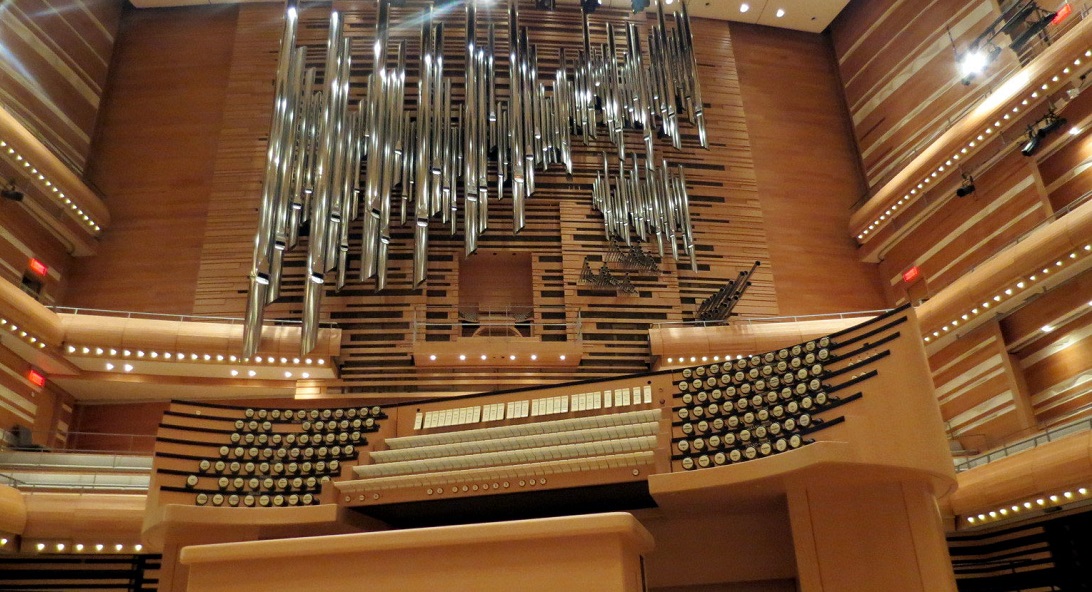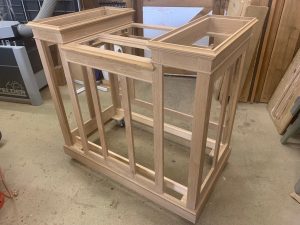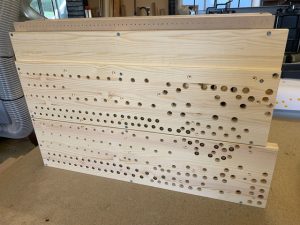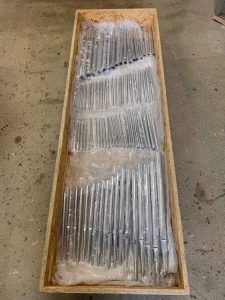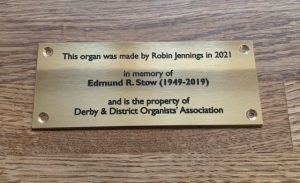Index
- The Organ of St Oswald’s Parish Church, Ashbourne
- Derby Cathedral (Compton)
- St. Peter’s, Belper
- All-Saints-Wingerworth
- St. Andrew’s Church, Swanwick
- Risley Parish Church
- St. James Riddings
- The Edmund Stow Memorial Organ
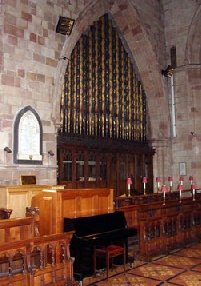
The Organ of St Oswald’s Parish Church, Ashbourne
The first organ of which there is any record was set up in the church in September 1710 by Henry Valentine of Leicester. The Rev. Nathaniel Boothouse, who was the Vicar at the time, noted in the church register, that its installation and dedication were celebrated by a series of services and recitals in which musicians from the choir of Lichfield Cathedral and other places took part. Ashbourne was, of course, in the Lichfield Diocese at that time. The Vicar noted further that the proceedings ended “…on the Wednesday night of the following week with a fine consert of Instrumental and Vocall Musick in the great parlour of the Blackamore’s head.”
That organ seems to have lasted until 1858 when William Hill of London installed the tracker action instrument that has developed into the present fine organ. When fitted, it had three manuals and pedals. There were eleven stops on the Great Organ, eleven on the Swell and six on the Choir with six pedal stops, five couplers and six composition pedals. It was dedicated to the memory of Edward Corden, a wealthy benefactor of the town and church.
In 1882, it was raised to its present position and improved, in recognition of the work of Benjamin Parkin, who had at that time been organist of the church for 25 years. He continued for a further 23 years so that when he retired in 1904, he had been organist for 48 years.
In 1951, a major rebuild was undertaken. The old tracker action was replaced by a detached console with electro-pneumatic action and stop keys. Some new stops were also added. Then in 1982, a further restoration took place. A new action was fitted together with an Ellen Playback Transmission System by Hill, Norman and Beard. This incorporated digital control so that the console could be moved to the tower crossing to provide for more effective use in concerts and recitals.
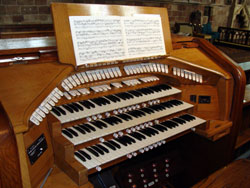
In 2011, Henry Groves and Son, restored and improved the organ. New stops were added and a nave division created. Two new blowers were incorporated. All shutters were improved and new shutters added to the west wall of the swell chamber.
Full Organ Specification
St. Oswald’s Church Full Organ Specification
Listen to this Organ
Derby Cathedral (Compton)
The present organ was built in 1939 by ‘ John Compton’ . Due to the intervening war it was without a case until 1963 when a case with dummy pipes was designed by Sebastian Comper. All the departments except the Swell relied heavily on the Extention system and stop duplication. there are 2 ranks of pipes from the Elliot Organ (1808-79) and 1,535 pipes from the Stringer Organ (1879-1939). The console had illuminated push-button stops and 4 manuals. The organ was opened with a recital by Dr George Thalben-Ball.
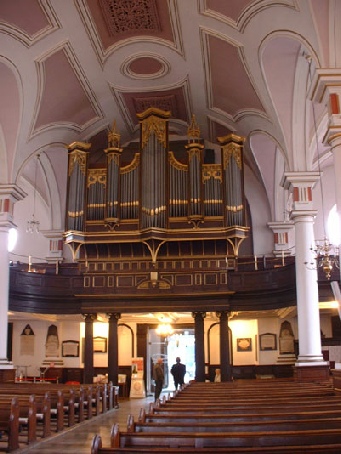
The present organ was built in 1939 by ‘ John Compton’ . Due to the intervening war it was without a case until 1963 when a case with dummy pipes was designed by Sebastian Comper. All the departments except the Swell relied heavily on the Extention system and stop duplication. there are 2 ranks of pipes from the Elliot Organ (1808-79) and 1,535 pipes from the Stringer Organ (1879-1939). The console had illuminated push-button stops and 4 manuals. The organ was opened with a recital by Dr George Thalben-Ball.
In 1992 Rushworth and Dreaper overhauled the organ making various tonal changes. The ‘Compton’ console was retained but was installed with a ‘ Modern Solid State Logic’ system .It was also made mobile by creating a detachable pedalboard. The re-opening Celebrity Recital was given by Thomas Trotter.
Full Organ Specification
Derby Cathedral (Compton) Full Organ Specification
Listen to this Organ
St. Peter’s, Belper

The organ was built by William Holt, Bradford in 1853 replacing a 7 stop organ that could have been by Snetzler. The opening on December 22nd the was a ‘Full Cathedral’ service given by Leeds Parish Church choir. The organ was of 2 manuals costing 300 Guineas (£315). The case of the present organ is the original case although it was later extended backwards.
In 1873 Radcliffe & Sagar enlarged the organ, providing a new console (still in use), increasing the swell organ from 42 to 54 notes and adding the Stop Diapason and Oboe. A 4 stop choir organ was also installed. In 1902 J.H.Adkins (Derby) carried out a mainly cosmetic ‘restoration’.
In 1938 the organ was decommissioned in favour of a Hammond Organ.
By the 1970’s thoughts turned to re-commissioning the organ. This was achieved in 1978 using volunteer labour under the direction of Edmund Stow (who turned professional organ builder in 1995).
Further modifications were undertaken by Wood of Huddersfield in 1992 which included the addition of a Trombone to the pedal organ. In 1998 Edmund Stow undertook further work.
Full Organ Specification
St. Peter’s, Belper Full Organ Specification
Listen to this Organ
All Saints Wingerworth

In 1755 a three manual organ built by Johann (John) Snetzler was installed in St Paul’s Parish Church, Pinstone Street, Sheffield at a cost of £313. In 1810 pedals were added by J Lincoln then in 1871 the organ was completely rebuilt by Brindley and Foster.
In 1939 following the closure of St Paul’s in 1936 the organ was installed in the newly built church of St Paul’s Arbourthorne. The re-building being undertaken by Cedric Arnold of Thaxted, Essex. In 1975 St Paul’s Arbourthorne in its turn closed.
Becoming too small for the congregation All Saints’ Wingerworth was extended in 1964. The extensions architect included an organ chamber in his design in preparation for when an organ would be installed. Following the closure of St Paul’s Arbourthorne the organ was installed in All Saint’s using voluntary labour under the supervision of John Poyser (Derby) the original case by Snetzler (enlarged at Arbourthorne ) was also installed and found to fit the opening left by the architect with 1/8” to spare.
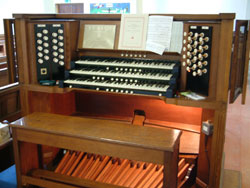
In 1998 a detailed report was commissioned to find how much and what historic material survived. It showed that the case was original Snetzler and that 300 pipes were also Snetzler though spread throughout the organ and at incorrect pitches.
In the summer of 2006 the old organ was dismantled by Henry Groves and Son, the Snetzler pipes restored, creating a Great organ with the same specification as the original Snetzler(except for the Tuba) and now on the original wind pressure of 2 7/8”
Full Organ Specification
All Saints Wingerworth Full Organ Specification
Listen to this Organ
St. Andrew’s Church, Swanwick

The organ was built by Nicholson and Lord of Walsall in 1885 and is situated in an open position at the east end of the nave north aisle. This is a generously sized 2 manual organ of good quality materials and pipes. There have been few alterations save the addition of a Tremulant and the substitution of a modern pedal board and balanced swell pedal, which are thought to have been added during the time of William Brown Haslam organst from 1910 to 1945.
During the 1990s the organ had become increasingly unreliable and by 1999 it was virtually unplayable. In 2000 major restoration work to the nave and chancel roofs necessitated the removal of all fixtures and fittings from the church, including the organ. At this time the PCC made the brave decision to add the full restoration of the organ to a growing list of major repairs and improvements required to the fabric of the building.
Peter Collins was appointed to undertake the organ restoration. Shortly before work on the roofs commenced the organ it was completely removed from the building. The church closed for six months during which time the Sixth Form Centre at Swanwick Hall School was used by the congregation for worship.
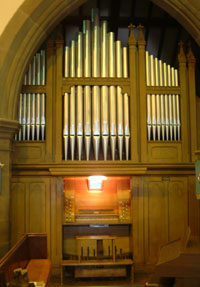
St Andrew’s reopened in November 2000, although the organ was not heard until early in 2001. Tonally the only alteration made was the addition of a missing Mixture rank, a 17th,which had been removed some years earlier.
Full Organ Specification
St. Andrew’s Church Swanwick Organ Specification
Listen to this Organ
Risley Parish Church
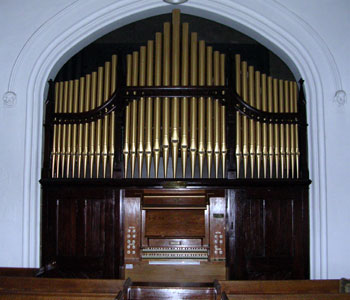
The organ was built in 1897 by Brindley & Foster and was paid for by Terah Hooley, a local business man.
In 1950 estimates for renovation and improvements were obtained from Henry Willis and Sons. See Willis’ letter and estimate.
In 2005 changes to the specification and mechanism were made by Jonathan Wallace of Henry Groves & Son, which were funded by donations and legacies.
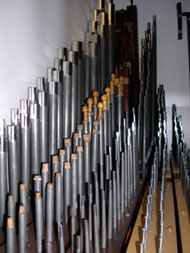
Before the 2005 overhaul there was a real lack of variety in the tone colours available for accompanying hymn singing and playing a lot of the organ repertoire. The string stops had their uses in softer playing and as a contrast to the flute sounds, but they didn’t really justify their place.
Now we have a lot of choices for hymn accompaniment – swell to the mixture is a bright and clear ‘organo pleno’ and everything works as it should.
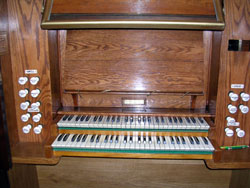
Full Organ Specification
Risley Parish Church Organ Specification
Listen to this Organ
St. James Riddings

St James’ Church was consecrated in 1832. Pevsner considered it a handsome building for its date. Built by Francis Bedford (who also built some of the Waterloo churches in London) it is in an early English gothic style. The church owes its existence to the generosity of James Oakes, the local industrialist and iron master of Riddings House, whose descendants were for the next 150 years benefactors of the church.
An interior feature of St James’ church is the west gallery on cast iron columns and it is upon the gallery, in the 1850’s, that Bevington & Sons of London built a one manual and pedal organ. The Swell organ was added during the 1880’s along with a new main case.
In 1923, thanks to the generosity of the organist George Henry Oakes, the organ was rebuilt by Blackett and Howden of Newcastle on Tyne at a cost of £850! The organ was enlarged to three manuals and a tubular-pneumatic action installed. During this rebuild a new console was built on the north side of the case incorporating the Bevington case of tripartite pattern above. In 1953 the organ was again rebuilt this time by Walker, albeit with no alterations to the 1923 specification.
By the mid 1990’s the tubular-pneumatic action was becoming increasingly unreliable and slow to speak. In 1995/6 Henry Grove & Son rebuilt the organ. The tubular-pneumatic action was converted to electro-pneumatic and the organ re-ordered and enlarged, whilst fully restoring all parts, re-leathering and augmenting the wind system. The Great Organ gained a Double Trumpet 16 and Clarion 4. On Choir Organ a Vox Angelica was substituted for a Piccolo 2, whilst the Pedal department gained a Double Trumpet 16, Trumpet 8 and Clarion 4. The bold -toned pipework was regulated to give of its best. The organ sounds magnificent, the 16ft reed stops gives one the impression of being in a cathedral.
Full Organ Specification
St. James Riddings Full Organ Specification
Listen to this Organ
The Edmund Stowe Memorial Organ, “Jennings Chamber Organ”
The chamber organ commissioned by the Association from Jennings Organs has now reached an exciting point of the construction process and it is hoped that it will be ready by December of this year. The new instrument has been made possible thanks to the generous legacy from the estate of the late Edmund R Stow, a fine organist, organ builder and member of the Association for many years.
Robin Jennings has built continuo organs and church organs for many years and has earned an enviable reputation for excellent craftsmanship and the musical quality of his instruments; we are very keen to see and hear our new organ. The instrument will remain in the possession of the Association, but will have a permanent home in Derby Cathedral where it will be used for concerts and accompanying the cathedral choir.
Based upon the design of a similar instrument in Trinity College, Cambridge, the organ will have four stops 8′, 4′, 4′, 2′ and be suitable for continuo playing and also for accompanying small congregations during more intimate services held in the Choir and Retro-Choir. The instrument will be moveable and will also have the facility to play at different pitches for the authentic accompaniment of music from earlier periods and different countries.
The term ‘box organ’ does not appear to be particularly English, but applies to the type of instrument that might also be named as ‘Postiv’, ‘Portativ’ or even ‘Chair Organ’. Essentially, it is an instrument of low height, the keyboard usually being above the pipes. A Chamber Organ usually implies something a little larger, often fixed in a particular ‘chamber’.
Robin Jennings https://jennings-organs.co.uk has made instruments for academic institutions and orchestras around the world, including The Orchestra of the Age of Enlightenment, under the direction of John Eliot Gardiner, an instrument that was used recently in a Promenade concert at the Royal Albert Hall.
The Derby Jennings Box Organ has now been completed and has been installed at Derby Cathedral.
